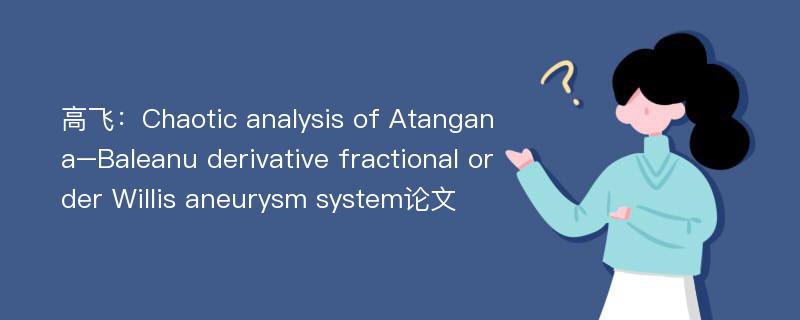
本文主要研究内容
作者高飞,李文琴,童恒庆,李喜玲(2019)在《Chaotic analysis of Atangana–Baleanu derivative fractional order Willis aneurysm system》一文中研究指出:A new Willis aneurysm system is proposed, which contains the Atangana–Baleanu(AB) fractional derivative.we obtain the numerical solution of the Atangana–Baleanu fractional Willis aneurysm system(ABWAS) with the AB fractional integral and the predictor–corrector scheme.Moreover, we research the chaotic properties of ABWAS with phase diagrams and Poincare sections.The different values of pulse pressure and system order are used to evaluate and compare their effects on ABWAS.The simulations verify that the changes of pulse pressure and system order are the significant reason for ABWAS’states varying from chaotic to steady.In addition, compared with Caputo fractional WAS(FWAS),ABWAS shows less state that is chaotic.Furthermore, the results of bifurcation diagrams of blood flow damping coefficient and reciprocal heart rate show that the blood flow velocity tends to stabilize with the increase of blood flow damping coefficient or reciprocal heart rate, which is consistent with embolization therapy and drug therapy for clinical treatment of cerebral aneurysms.Finally, in view of the fact that ABWAS in chaotic state increases the possibility of rupture of cerebral aneurysms, a reasonable controller is designed to control ABWAS based on the stability theory.Compared with the control results of FWAS by the same method, the results show that the blood flow velocity in the ABWAS system varies in a smaller range.Therefore, the control effect of ABWAS is better and more stable.The new Willis aneurysm system with Atangana–Baleanu fractional derivative provides new information for the further study on treatment and control of brain aneurysms.
Abstract
A new Willis aneurysm system is proposed, which contains the Atangana–Baleanu(AB) fractional derivative.we obtain the numerical solution of the Atangana–Baleanu fractional Willis aneurysm system(ABWAS) with the AB fractional integral and the predictor–corrector scheme.Moreover, we research the chaotic properties of ABWAS with phase diagrams and Poincare sections.The different values of pulse pressure and system order are used to evaluate and compare their effects on ABWAS.The simulations verify that the changes of pulse pressure and system order are the significant reason for ABWAS’states varying from chaotic to steady.In addition, compared with Caputo fractional WAS(FWAS),ABWAS shows less state that is chaotic.Furthermore, the results of bifurcation diagrams of blood flow damping coefficient and reciprocal heart rate show that the blood flow velocity tends to stabilize with the increase of blood flow damping coefficient or reciprocal heart rate, which is consistent with embolization therapy and drug therapy for clinical treatment of cerebral aneurysms.Finally, in view of the fact that ABWAS in chaotic state increases the possibility of rupture of cerebral aneurysms, a reasonable controller is designed to control ABWAS based on the stability theory.Compared with the control results of FWAS by the same method, the results show that the blood flow velocity in the ABWAS system varies in a smaller range.Therefore, the control effect of ABWAS is better and more stable.The new Willis aneurysm system with Atangana–Baleanu fractional derivative provides new information for the further study on treatment and control of brain aneurysms.
论文参考文献
论文详细介绍
论文作者分别是来自Chinese Physics B的高飞,李文琴,童恒庆,李喜玲,发表于刊物Chinese Physics B2019年09期论文,是一篇关于,Chinese Physics B2019年09期论文的文章。本文可供学术参考使用,各位学者可以免费参考阅读下载,文章观点不代表本站观点,资料来自Chinese Physics B2019年09期论文网站,若本站收录的文献无意侵犯了您的著作版权,请联系我们删除。
